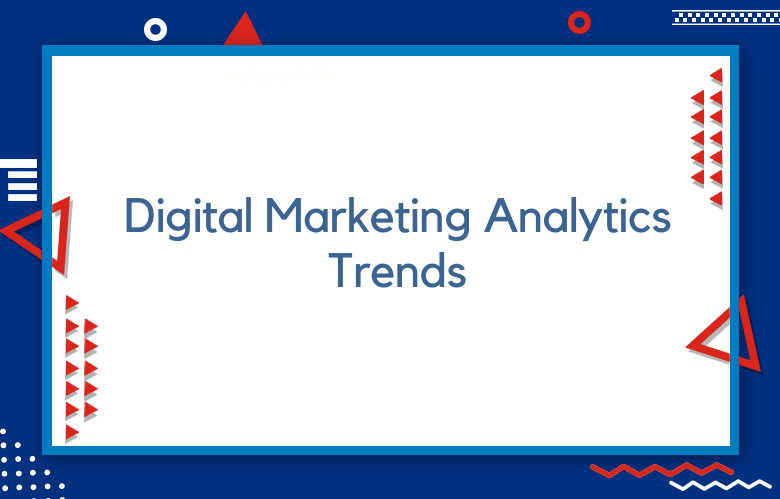Digital Marketing Analytics Trends That You Should Not Ignore in 2024

As we step into 2024, the landscape of digital marketing analytics is witnessing significant transformations. With the explosion of data sources and the increasing sophistication of analytical tools, marketers are poised to unlock unprecedented insights into consumer behavior, campaign performance, and strategic outcomes.
Digital Marketing Analytics Trends That You Should Not Ignore in 2024
This year, trends such as predictive analytics, real-time data processing, and the integration of AI in marketing strategies are becoming increasingly vital. These advancements offer marketers not just the ability to track performance but also to foresee and adapt to market dynamics proactively.
Understanding and leveraging these trends will be crucial for businesses aiming to maintain a competitive edge in a digitally dominated marketplace. This introduction will explore the key trends in digital marketing analytics that businesses should not overlook in 2024, emphasizing how they can transform both strategic planning and tactical execution.
Top Digital Marketing Analytics Trends Shaping 2024
As we march into 2024, the realm of digital marketing analytics is experiencing transformative shifts shaped by advancements in technology and changing consumer behaviors. This dynamic field is seeing the rise of artificial intelligence, machine learning, and enhanced data integration, driving more precise and actionable insights for marketers.
The ability to analyze vast amounts of data in real time and predict future trends is becoming a fundamental component of effective digital marketing strategies. This introduction will delve into the top digital marketing analytics trends of 2024, highlighting how they are poised to redefine the ways businesses connect with their customers, optimize their marketing efforts, and drive growth in an increasingly digital world.
The Ultimate Guide to Leveraging Digital Marketing Analytics in 2024
In 2024, leveraging digital marketing analytics is more crucial than ever for businesses aiming to thrive in a highly competitive digital landscape. This comprehensive guide is designed to help marketers harness the power of analytics to improve their strategies and achieve better outcomes. Here are the essential areas of focus for effectively utilizing digital marketing analytics:
Data Integration: Combining data from multiple sources to get a holistic view of the customer journey. This integration allows marketers to create more targeted, personalized campaigns and improve customer experience.
Predictive Analytics: Utilizing AI and machine learning to analyze current and historical data to predict future behavior. This enables proactive decision-making and more precise targeting.
Real-Time Analytics: Monitoring and responding to customer interactions and campaign performance in real time to make immediate adjustments. This agility helps in optimizing campaigns on the fly and enhances the effectiveness of marketing efforts.
Customer Segmentation: Using advanced analytics to segment customers more accurately according to various criteria such as behavior, demographics, and purchase history. This segmentation helps in crafting messages that are more likely to resonate with different groups.
ROI Measurement: Developing more sophisticated methods for measuring the return on investment of marketing campaigns. This involves correlating specific actions and engagements directly with outcomes, making it easier to quantify the impact of digital marketing efforts.
Voice and Visual Search Optimization: As voice and visual searches become more popular, optimizing content for these types of queries is essential. This includes using natural language processing and image recognition technologies to ensure visibility in search results.
Privacy and Compliance: With tightening regulations on data privacy, such as GDPR and CCPA, ensuring compliance while still being able to collect and analyze data is a key challenge. Marketers need to use analytics tools that respect user privacy and data protection laws.
Advanced Visualization Tools: Employing sophisticated visualization tools to present data in an understandable and actionable manner. This helps stakeholders quickly grasp insights and make informed decisions.
By focusing on these areas, marketers can effectively leverage digital marketing analytics to drive growth and innovation. Staying ahead of the curve with the latest tools and techniques is essential for maximizing the impact of your digital marketing efforts in 2024.
Uncovering the Latest Digital Marketing Analytics Trends for 2024
As we enter 2024, the digital marketing landscape is evolving at an unprecedented pace, driven by rapid advancements in technology and changes in consumer behavior.
Understanding the latest trends in digital marketing analytics is crucial for businesses aiming to stay competitive and effectively engage with their audiences. This introduction will explore the emerging trends that are reshaping how companies collect, analyze, and act on digital data.
From the integration of AI and machine learning for deeper insights to the increasing importance of privacy-focused analytics in response to consumer demands, the focus will be on how these developments can be leveraged to drive strategic decision-making and create more personalized marketing campaigns. This will set the stage for a comprehensive look at what businesses can expect in the year ahead and how they can prepare to make the most of these changes.
Stay Ahead of the Curve: Key Digital Marketing Analytics Trends for 2024
As we gear up for 2024, staying ahead in the rapidly evolving field of digital marketing analytics is crucial for marketers aiming to harness the full potential of their strategies. This year, we are seeing the emergence of several key trends that are set to redefine the approach to data-driven marketing.
Innovations in AI and machine learning are enabling deeper insights and more automated decision-making, while the increasing importance of privacy regulations is challenging marketers to balance effective targeting with compliance.
The integration of new data sources and the continuous advancement in real-time analytics technologies are opening up new opportunities for personalized customer engagement at scale. This introduction will explore the significant digital marketing analytics trends for 2024, providing insights into how marketers can utilize these developments to optimize their campaigns and stay competitive in a digital-first world.
Digital Marketing Analytics Trends: What You Need to Know
As we approach 2024, digital marketing analytics continues to be a critical driver of business strategy, offering invaluable insights into consumer behavior and campaign effectiveness. In this rapidly changing digital environment, staying ahead means keeping pace with the latest advancements in analytics technologies and methodologies.
This introduction will lay the groundwork for understanding the key trends that are defining the field of digital marketing analytics in 2024. From the rise of predictive analytics powered by artificial intelligence to the growing emphasis on privacy and ethical data use, these trends are not just shaping how organizations collect and interpret data, but also how they implement these insights to achieve tangible business outcomes.
We will explore how these developments can help marketers refine their strategies, optimize customer engagement, and ultimately, drive more informed, data-driven decision making across industries.
Mastering Digital Marketing Analytics: Trends to Watch in 2024
As we navigate through 2024, the field of digital marketing analytics is advancing rapidly, and mastering these developments is essential for marketers who wish to excel in a data-driven environment. This year, several key trends are shaping the industry, each offering new tools and methodologies that can significantly enhance the efficacy and precision of digital marketing efforts. Here’s what to watch:
AI-Driven Predictive Analytics: Artificial intelligence continues to transform digital marketing analytics by providing predictive insights that help marketers anticipate consumer behaviors and preferences before they manifest.
Increased Focus on Data Privacy and Ethics: With global data protection regulations becoming stricter, marketers must prioritize the ethical collection and use of data, ensuring privacy compliance without compromising the quality of insights.
Integration of Cross-Channel Data: As consumers interact across multiple digital platforms, integrating data from all these sources is crucial for creating a unified view of the customer journey, enabling more coherent and targeted marketing strategies.
Real-Time Data Analysis: The ability to analyze and respond to data in real-time allows marketers to be more agile, making instant adjustments to campaigns based on current consumer interactions and behaviors.
Enhanced Visualization Tools: Advanced data visualization tools are becoming indispensable in digital marketing analytics, helping to distill complex datasets into clear, actionable insights that can be easily understood and acted upon by decision-makers.
Voice and Visual Search Optimization: With the rise of voice-activated assistants and visual search technologies, optimizing for these search inputs is becoming crucial, requiring new strategies and tools for effective SEO and content visibility.
Quantifying ROI with Greater Accuracy: New analytics technologies and methods are improving how marketers measure the return on investment, providing more detailed insights into the effectiveness of each campaign and marketing dollar spent.
By staying informed about these trends, marketers can not only enhance their current practices but also drive innovation within their organizations, ensuring that their digital marketing strategies remain robust and responsive to the evolving digital landscape.
Elevate Your Strategy: Essential Digital Marketing Analytics Trends for 2024
As we head into 2024, the importance of digital marketing analytics in shaping successful strategies cannot be overstated. With the digital landscape continuously evolving, staying informed about the latest trends in analytics is essential for marketers looking to elevate their strategies and maintain a competitive edge. This guide will delve into the key trends that every digital marketer should be aware of in the upcoming year.
We will explore advancements in AI-driven analytics that provide deeper, more actionable insights, the shift towards real-time data processing for agile decision-making, and the critical role of privacy-first analytics in building consumer trust. Additionally, we’ll examine the rise of multi-touch attribution models that offer a more nuanced view of customer journeys and the increasing integration of analytics into user experience design to enhance customer engagement.
Understanding these trends will not only help marketers optimize their current campaigns but also anticipate future changes, allowing for strategic planning that aligns with both technological advancements and evolving consumer expectations. Let’s dive into these essential digital marketing analytics trends for 2024, equipping you with the knowledge to not just participate but thrive in the digital marketing arena.
Conclusion:
As we move into 2024, businesses should be vigilant and proactive in adapting to the evolving landscape of digital marketing analytics. The trends that are set to dominate include the integration of AI and machine learning for enhanced predictive analytics, the rise of real-time data analysis for immediate decision-making, and an increased focus on privacy and security in data handling.
The use of omnichannel strategies and customer data platforms will enable a more unified view of the customer journey, allowing for more personalized and effective marketing efforts. Staying ahead of these trends will not only provide competitive advantages but also ensure that businesses remain relevant and responsive to the ever-changing digital marketing environment. By embracing these innovations, companies can unlock powerful insights, optimize their marketing strategies, and drive substantial growth in the digital age.
Call: +91 9848321284
Email: [email protected]



